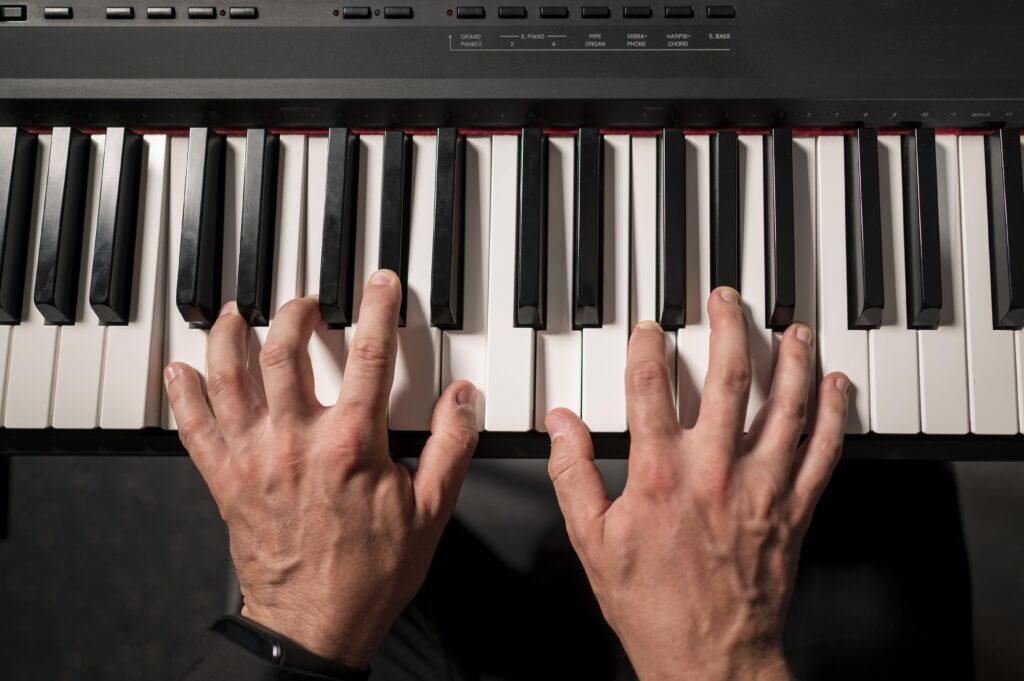Chord Conquest: Mastering the Essential Piano Chords for Beginners
If you’re a beginner pianist, it can be overwhelming to know where to start with learning chords. With so many options to choose from, it’s important to focus on the best chords to learn that will provide a solid foundation for your playing. In this article, we’ll explore some of the best piano chords to learn to help you progress in your musical journey.

First and foremost, it’s important to master the basic major and minor chords. These chords are the building blocks of most songs and will be used frequently in your playing. Major chords have a happy, upbeat sound while minor chords have a more melancholy, sad sound. Learning both major and minor chords will allow you to play a wide range of songs and also help you understand the emotional impact that different chords can have on a piece of music.
Another important chord to learn is the seventh chord. This chord adds a bit of complexity to your playing and can create a more jazzy or bluesy sound. Seventh chords are often used in more advanced pieces of music, but learning them early on will give you a head start in your playing. By mastering these essential chords, you’ll be well on your way to becoming a proficient pianist.
Fundamentals of Piano Chords
Learning piano chords is an essential part of becoming a proficient pianist. Chords are the foundation of most music, and understanding them will enable you to play a wide range of songs. In this section, we will cover the basics of piano chords, including major and minor chords.
Major Chords
Major chords are the most common type of chord in music and are often used to create a happy, uplifting sound. They are made up of three notes, the root note, the major third, and the perfect fifth. For example, the C major chord consists of the notes C, E, and G.
To play a major chord on the piano, you need to play the root note with your left hand and the remaining two notes with your right hand. You can play the notes simultaneously or in succession, depending on the song’s tempo.
Minor Chords
Minor chords are the opposite of major chords and are often used to create a sad or melancholic sound. They are also made up of three notes, the root note, the minor third, and the perfect fifth. For example, the A minor chord consists of the notes A, C, and E.
To play a minor chord on the piano, you need to play the root note with your left hand and the remaining two notes with your right hand. As with major chords, you can play the notes simultaneously or in succession.
Mastering the fundamentals of piano chords is crucial for anyone looking to become a proficient pianist. By understanding major and minor chords, you will be able to play a wide range of songs and create different moods and emotions through your playing.
Chord Progressions and Transitions
Circle of Fifths
The Circle of Fifths is a powerful tool that can help you understand the relationships between chords. It is a visual representation of the twelve tones of the chromatic scale, arranged in a circle. Each tone is a fifth apart from the next, and the circle moves clockwise through the keys. By following the circle, you can easily see which chords are related to each other and how they can be used in a progression.
Two-Five-One Progression
The Two-Five-One (2-5-1) progression is one of the most common chord progressions in music. It is used in many different genres, including jazz, blues, and pop. The 2-5-1 progression is a three-chord progression that moves from the second degree of the scale to the fifth degree, and then to the first degree. For example, in the key of C, the 2-5-1 progression would be Dm7-G7-Cmaj7.
Using chord progressions and transitions can help you create a cohesive and interesting piece of music. The Circle of Fifths and the Two-Five-One progression are just two examples of the many tools available to help you improve your piano playing. By mastering these techniques, you can take your music to the next level and impress your audience with your skills.
Extended and Altered Chords
When you’re looking to expand your piano chord repertoire, extended and altered chords can add a lot of flavour and complexity to your playing. These chords are built by adding additional notes to basic triads and seventh chords, creating rich and interesting harmonies.
Seventh Chords
Seventh chords are a great place to start when exploring extended chords. These chords add a fourth note to the basic triad, creating a more complex sound. Some common seventh chords include:
- Major seventh (maj7): This chord adds a major seventh interval to the basic major triad. For example, a Cmaj7 chord would include the notes C, E, G, and B.
- Dominant seventh (7): This chord adds a minor seventh interval to the basic major triad. For example, a C7 chord would include the notes C, E, G, and Bb.
- Minor seventh (m7): This chord adds a minor seventh interval to the basic minor triad. For example, a Cm7 chord would include the notes C, Eb, G, and Bb.
Suspended Chords
Suspended chords are another type of extended chord that can add a unique sound to your playing. These chords replace the third note of the basic triad with either a second or fourth note, creating a suspended sound. Some common suspended chords include:
- Suspended second (sus2): This chord replaces the third note of the basic triad with a second note. For example, a Csus2 chord would include the notes C, D, and G.
- Suspended fourth (sus4): This chord replaces the third note of the basic triad with a fourth note. For example, a Csus4 chord would include the notes C, F, and G.
By incorporating extended and altered chords into your playing, you can create a more complex and interesting sound. Experiment with these chords to find new and unique ways to enhance your piano playing.
Chord Inversions and Voicings
When it comes to playing the piano, chord inversions and voicings are essential skills that can add depth and complexity to your playing. Inversions refer to the rearrangement of the notes in a chord, while voicings refer to the way the notes of a chord are distributed across different octaves.
Root Position
The root position is the most basic form of a chord, with the root note as the lowest note in the chord. For example, a C major chord in root position consists of the notes C, E, and G, with C as the lowest note.
First Inversion
In the first inversion, the third of the chord becomes the lowest note. For example, a C major chord in the first inversion consists of the notes E, G, and C, with E as the lowest note. First inversions are often used to create a sense of tension and release in music.
Second Inversion
In the second inversion, the fifth of the chord becomes the lowest note. For example, a C major chord in the second inversion consists of the notes G, C, and E, with G as the lowest note. Second inversions are often used to create a sense of instability or movement in music.
Learning chord inversions and voicings can greatly enhance your piano playing and open up new possibilities. Experiment with different inversions and voicings to find the ones that work best for you and your playing style.
Practice Techniques

Finger Independence
Finger independence is a crucial skill to develop when playing piano chords. It allows you to play complex chords with ease and precision. Try practising scales and arpeggios with each finger individually to improve your finger independence. You can also try playing simple chord progressions with one hand and focusing on using each finger to play its respective note.
Chord Repetition
Repetition is key to mastering any skill, and playing piano chords is no exception. Practice playing the same chord progression repeatedly until you can play it smoothly and without mistakes. Start with simple progressions and gradually move on to more complex ones. You can also try playing along with a metronome to improve your timing and accuracy.
By incorporating these practice techniques into your routine, you can improve your finger independence and chord repetition skills, making it easier to play a wide variety of piano chords. Remember to practice regularly and be patient with yourself as you work towards mastering these skills.






